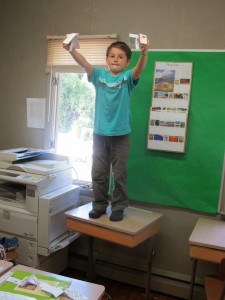To start the year, the oldest students were challenged to learn as much as they could about bugscopters – a t-shaped, paper, helicopter-like creation of Larry Schafer, formerly professor of Science Teaching at SU. After exploring the characteristics of the bugsocopters, by dropping them from on high, we discussed the need to limit variables when conducting experiments.
Each child was given a standard bugscopter, which was tested against another bugsocopter that varied in one dimension. With each new experiment students were given two options of a bugscopter to compare with their Standard. Only one bugsocopter changed in one dimension. So children practiced their understanding of limiting one variable with every experiment completed.
The children completed 6 experiments either comparing their standard bugsocopter with another one that had shorter wings, fatter wings, wings apart, had more paper clips, a fatter body or a shorter body. With each experiment or change in one variable, students created a histogram recording whether the second bugsocopter fell faster, slower or the same as their Standard. They also recorded the twirling habits of the bugscopters in the same way.
In the process of this short unit students are introduced to the need in experimentation to keep everything the same except the variable being tested. They see how histograms can be used to compile and interpret observations. They are encouraged to make careful observations and to stand by those observations. And they experience the excitement of making discoveries.

